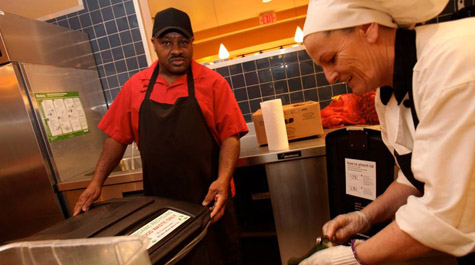New sustainability efforts are underway at the College of William and Mary this fall, as the Student Assembly expanded its executive branch with the creation of a sustainability department and the College’s Office of Sustainability began development on a plan for the future of sustainability on campus.
According to SA President Elijah Levine ’18, sustainability is important because it impacts marginalized people to a greater extent.
There’s such an extent to which [the] sustainability issue is not just about our physical surroundings but it is very much a social issue,” Levine said. “It’s very much true that marginalized people, people of color, are affected first and to a greater extent by climate change. If we don’t assess the problem intersectionally in that way, if we don’t see how it gets at the very fabric … of the institutions that we take for granted, it’s only treating a symptom of the problem, and we need to get to the root.”
“There’s such an extent to which [the] sustainability issue is not just about our physical surroundings but it is very much a social issue,” Levine said. “It’s very much true that marginalized people, people of color, are affected first and to a greater extent by climate change. If we don’t assess the problem intersectionally in that way, if we don’t see how it gets at the very fabric … of the institutions that we take for granted, it’s only treating a symptom of the problem, and we need to get to the root.”
According to Levine, SA’s new department on sustainability launched Sept. 12 after a unanimous vote by the senate.
The department will be headed by a secretary and two undersecretaries who will focus on food and waste policy and energy policy, respectively.
“The two undersecretary positions I think speak to the big part to sustainability that any campus is going to face, which is ‘How do we go about sustainably sourcing food and disposing of that food and how do we power all these buildings in a responsible way?’” Levine said. “So, in that sense, the energy position is going to be a lot of research, and we’re hoping to try to speak out for another energy audit or report. We haven’t had a full analysis since 2008.”
Levine said that SA would aim to “build on the small steps” that have already occurred on campus to make the College more environmentally conscious, including the composting initiative at Marketplace, with a focus on raising the College community’s awareness.
Additionally, SA Vice President Annelise Yackow ’18 said that they are working on a carbon offset program with vans for Steer Clear, which is a continuation of a project SA began last year.
Levine also said that SA was considering partnering with organizations like the Student Environmental Action Coalition and Campus Kitchen in the future to strengthen their sustainability efforts. However, SEAC Co-Facilitator Brendan Thomas ’18 noted that any collaboration with SA would be done on an individual basis.
“SEAC is explicitly not an institutional organization, so we work with more grassroots activism, things that we see as more important for students to get involved in,” Thomas said. “So we might encourage people to partner with SA or [the] Committee on Sustainability, but as an organization we don’t necessarily co-sponsor things like that.”
Thomas did say, however, that SEAC has subcommittees that specifically work with College organizations and administration on policies.
Along with student initiatives, Director of Sustainability Calandra Waters Lake said that the College is planning on developing a campus-wide plan for sustainability, starting this fall.
We are going to be putting together a comprehensive plan that will look over the next few years and determine where our priorities are, what will our goals be, our commitments, basically where do we see sustainability going at William and Mary,” Lake said. “We’ll have opportunities both online and in person for students, faculty and staff to provide us feedback on where they think sustainability should be going. Essentially, this is your ship to steer.”
“We are going to be putting together a comprehensive plan that will look over the next few years and determine where our priorities are, what will our goals be, our commitments, basically where do we see sustainability going at William and Mary,” Lake said. “We’ll have opportunities both online and in person for students, faculty and staff to provide us feedback on where they think sustainability should be going. Essentially, this is your ship to steer.”
Although the College’s Green Fee program was active again this summer, awarding over $50,000 to various student, faculty and staff projects including Branch Out’s waste reduction proposal and a permaculture demonstration garden, both Levine and Yackow felt that the College could be doing more when it comes to sustainability initiatives.
According to Levine, the College puts an emphasis on creating task forces and conducting surveys and analysis, instead of implementing new sustainable policies.
Thomas said that institutionally-supported projects like Green Fees and the building of reusable water bottle fountains promote environmentalism as an individual initiative. Thomas believes that this approach misreads the issue, because he believes that climate change is caused by systems and structures that are oppressive.
“It’s not a cure-all solution like it’s being framed as, and I think it’s a way for the university to avoid looking at the structural problems that create and promote our contribution to climate change, like the fact that we invest in fossil fuels and that we don’t have a particularly sustainable campus,” Thomas said.

